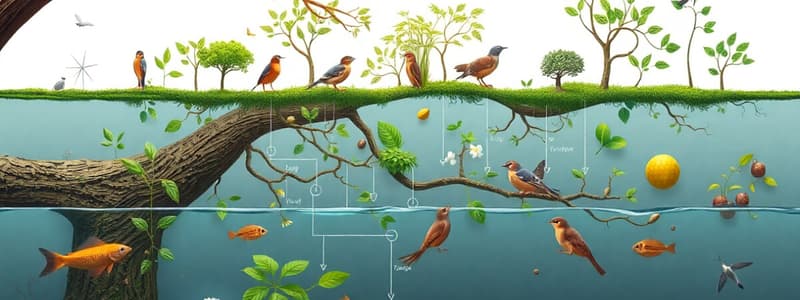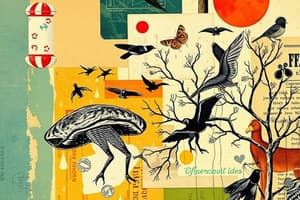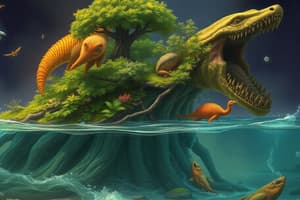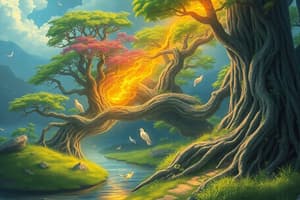Podcast
Questions and Answers
What role do plants play in an ecosystem?
What role do plants play in an ecosystem?
- Apex predators
- Secondary consumers
- Producers (correct)
- Primary consumers
Secondary consumers primarily eat plants.
Secondary consumers primarily eat plants.
False (B)
What term describes the relationship where all aspects of an ecosystem rely on other parts?
What term describes the relationship where all aspects of an ecosystem rely on other parts?
Interdependence
In an ecosystem, _______ are known as non-living things, such as rocks and soil.
In an ecosystem, _______ are known as non-living things, such as rocks and soil.
Match the following types of consumers with their definitions:
Match the following types of consumers with their definitions:
State the definition of an ecosystem.
State the definition of an ecosystem.
Select the two things that flow through an ecosystem.
Select the two things that flow through an ecosystem.
Important _______ link ____ and ____ parts of the ecosystem together.
Important _______ link ____ and ____ parts of the ecosystem together.
What is the primary consequence of a change in a food chain within an ecosystem?
What is the primary consequence of a change in a food chain within an ecosystem?
Biomass refers to the total quantity or weight of organisms in a specific area or ecosystem.
Biomass refers to the total quantity or weight of organisms in a specific area or ecosystem.
Name one human activity that can lead to ecosystem change.
Name one human activity that can lead to ecosystem change.
Wolves introduced in Yellowstone National Park helped control the population of __________.
Wolves introduced in Yellowstone National Park helped control the population of __________.
What percentage of energy is typically passed to the next trophic level in a food chain?
What percentage of energy is typically passed to the next trophic level in a food chain?
The introduction of alien species can have a neutral effect on ecosystems.
The introduction of alien species can have a neutral effect on ecosystems.
What effect did the increase in wolves have on the geography of Yellowstone National Park?
What effect did the increase in wolves have on the geography of Yellowstone National Park?
A food web is a network of interconnected __________ within an ecosystem.
A food web is a network of interconnected __________ within an ecosystem.
Match the following causes of ecosystem change with their effects:
Match the following causes of ecosystem change with their effects:
Explain why there is a decrease in biomass at each level of a food chain.
Explain why there is a decrease in biomass at each level of a food chain.
Name at least 3 ways energy is lost in an ecosystem.
Name at least 3 ways energy is lost in an ecosystem.
Name the case study for change in an ecosystem.
Name the case study for change in an ecosystem.
From the years of ____ to ____ there were ____ wolves introduced and on average there are an estimated ____ wolves present day.
From the years of ____ to ____ there were ____ wolves introduced and on average there are an estimated ____ wolves present day.
After the reintroduction of 41 wolves in Yellowstone National Park, many species _____ increased such as ___ and mice. Wolves helped control the growing ___ population. This meant that more ______ grew. This was good because it meant the ____ population increased. The beavers built ___ in rivers which led to more _____ being created for ____ and fish. In this way, a _____ multiplier effect occurred.
However, wolves didn't just change the ______ but the ____ geography as well. This meant that the rivers _____ less and less erosion led to ____ forming. This was good because it is great for wildlife _____.
After the reintroduction of 41 wolves in Yellowstone National Park, many species _____ increased such as ___ and mice. Wolves helped control the growing ___ population. This meant that more ______ grew. This was good because it meant the ____ population increased. The beavers built ___ in rivers which led to more _____ being created for ____ and fish. In this way, a _____ multiplier effect occurred.
However, wolves didn't just change the ______ but the ____ geography as well. This meant that the rivers _____ less and less erosion led to ____ forming. This was good because it is great for wildlife _____.
After the reintroduction of wolves into Yellowstone National Park it meant that there was now a ____ in the park. This means that levels of ____ decreases. This is bad because the park would receive less ____ from tourism. In this way a ____ multiplier effect occurs.
After the reintroduction of wolves into Yellowstone National Park it meant that there was now a ____ in the park. This means that levels of ____ decreases. This is bad because the park would receive less ____ from tourism. In this way a ____ multiplier effect occurs.
Where do deserts and rainforests form in relation to global atmospheric circulation?
Where do deserts and rainforests form in relation to global atmospheric circulation?
A biome is a large _____ consisting of a specific ___ and ___ which is spread across _____ and shares a common _____.
A biome is a large _____ consisting of a specific ___ and ___ which is spread across _____ and shares a common _____.
Describe the local factor that causes the creation of arid biomes.
Describe the local factor that causes the creation of arid biomes.
Thermohaline Circulation is the process of ocean currents carrying heat from the equator towards the poles.
Thermohaline Circulation is the process of ocean currents carrying heat from the equator towards the poles.
What is biodiversity?
What is biodiversity?
Why is there so much life in a tropical rainforest?
Why is there so much life in a tropical rainforest?
What is nutrients?
What is nutrients?
Tropical rainforests have very soils which are very high quality due to their good growing conditions.
Tropical rainforests have very soils which are very high quality due to their good growing conditions.
____ occurs as a result of an efficient nutrient cycle.
____ occurs as a result of an efficient nutrient cycle.
Match the transfer of nutrients with how they take place:
Match the transfer of nutrients with how they take place:
Match the transfer of nutrients with how they take place:
Match the transfer of nutrients with how they take place:
What is the main function of the canopy layer in a forest?
What is the main function of the canopy layer in a forest?
Emergent trees do not receive as much sunlight as under canopy trees.
Emergent trees do not receive as much sunlight as under canopy trees.
What adaptations help poison dart frogs avoid predators?
What adaptations help poison dart frogs avoid predators?
Buttress roots are big and thick like a _____ because they serve to support the ___ trees.
Buttress roots are big and thick like a _____ because they serve to support the ___ trees.
Lianas thrive in darkness and are found predominantly on the forest floor.
Lianas thrive in darkness and are found predominantly on the forest floor.
What is the primary environment condition that plants adapt to in the forest?
What is the primary environment condition that plants adapt to in the forest?
Match the following tree types with their characteristics:
Match the following tree types with their characteristics:
Aye-ayes have large eyes to see in the ___ and have dark fur for _______. They are also _____ to hunt in the safety of darkness. They have a long ____ ____ to get in cracks and crevices to find prey.
Aye-ayes have large eyes to see in the ___ and have dark fur for _______. They are also _____ to hunt in the safety of darkness. They have a long ____ ____ to get in cracks and crevices to find prey.
Which of the following is a characteristic of lianas in the forest?
Which of the following is a characteristic of lianas in the forest?
Which adaptations do dripleaves have? (Select all that apply)
Which adaptations do dripleaves have? (Select all that apply)
Why are trees in the rainforest adapted to have a thick, tall, and straight trunk as well as to have no leaf growth anywhere but the top?
Why are trees in the rainforest adapted to have a thick, tall, and straight trunk as well as to have no leaf growth anywhere but the top?
What is the primary economic benefit of palm oil production in Malaysia?
What is the primary economic benefit of palm oil production in Malaysia?
Logging is the main cause of deforestation in Malaysia.
Logging is the main cause of deforestation in Malaysia.
Name one consequence of deforestation on climate change.
Name one consequence of deforestation on climate change.
In Malaysia, approximately _____ of the country is covered by tropical rainforest.
In Malaysia, approximately _____ of the country is covered by tropical rainforest.
Match each cause of deforestation with its description:
Match each cause of deforestation with its description:
What percentage of Malaysia's biodiversity and how many species are found in the main range?
What percentage of Malaysia's biodiversity and how many species are found in the main range?
Soil erosion can occur within hours despite taking thousands of years for soil to form.
Soil erosion can occur within hours despite taking thousands of years for soil to form.
What is one positive impact of palm oil on the Malaysian economy?
What is one positive impact of palm oil on the Malaysian economy?
How many hectares of palm oil plantation are there in Malaysia?
How many hectares of palm oil plantation are there in Malaysia?
State 2 reasons why palm oil is more profitable than other oil types.
State 2 reasons why palm oil is more profitable than other oil types.
Malaysia has been the largest exporter of tropical wood since the ___s as a result from ____. It has been recently replaced by _____ logging.
Malaysia has been the largest exporter of tropical wood since the ___s as a result from ____. It has been recently replaced by _____ logging.
Mining mainly __ and _____ is common in the Malaysian peninsula. Drilling for __ and __ has recently started on ____.
Mining mainly __ and _____ is common in the Malaysian peninsula. Drilling for __ and __ has recently started on ____.
State an effect caused by the loss of biodiversity.
State an effect caused by the loss of biodiversity.
Select the correct meanings of sustainability:
Select the correct meanings of sustainability:
Match why we need to protect rainforests with the corresponding percentage:
Match why we need to protect rainforests with the corresponding percentage:
Match the following sustainable development strategies with their descriptions:
Match the following sustainable development strategies with their descriptions:
The Trans-Alaskan pipeline is buried underground to protect permafrost.
The Trans-Alaskan pipeline is buried underground to protect permafrost.
What major ecological issue does Greenpeace focus on in the Arctic and what other organisation helps to protect the arctic?
What major ecological issue does Greenpeace focus on in the Arctic and what other organisation helps to protect the arctic?
Extreme temperatures in cold environments can cause oil spills, which destroy ____ environments.
Extreme temperatures in cold environments can cause oil spills, which destroy ____ environments.
Match the following environmental statistics about Costa Rica with their corresponding values:
Match the following environmental statistics about Costa Rica with their corresponding values:
What is involved in selective logging?
What is involved in selective logging?
Explain how selective logging reduces deforestation.
Explain how selective logging reduces deforestation.
Which of the following certifications are involved in Eco-tourism in Costa Rica? (Select all that apply)
Which of the following certifications are involved in Eco-tourism in Costa Rica? (Select all that apply)
Explain how eco-tourism in Costa Rica reduces deforestation.
Explain how eco-tourism in Costa Rica reduces deforestation.
The Forest Stewardship Council (FSC) ___ the forest into parts. Every __ they harvest a couple trees in every part. They then leave that part to regenerate over __ years. They also make sure that ___ ___ work in safe conditions as well as making sure ____ ___ are well respected.
The Forest Stewardship Council (FSC) ___ the forest into parts. Every __ they harvest a couple trees in every part. They then leave that part to regenerate over __ years. They also make sure that ___ ___ work in safe conditions as well as making sure ____ ___ are well respected.
Explain how the Forest Stewardship Council (FSC) reduces deforestation.
Explain how the Forest Stewardship Council (FSC) reduces deforestation.
The Arctic National Wildlife Refuge in Alaska was established in ___ and protects ___ million acres of economic development.
The Arctic National Wildlife Refuge in Alaska was established in ___ and protects ___ million acres of economic development.
What does the Trans-Alaskan pipeline allow?
Why is it raised above the ground?
What does it also allow Carribou to do?
What does the Trans-Alaskan pipeline allow? Why is it raised above the ground? What does it also allow Carribou to do?
Cold Environments are damaged by...
In Alaska, __ ___ ____ is a popular tourist activity. This creates ___ ____, and so other avoid the deep tracks which leads to the destruction of ______.
Cold environments are rich in ____ ______ and humans have to build ____ and _______ to access them. This leads to the destruction of ______.
Exstreme ________ can cause oil pipelines to break, leading to __ ____. This leads to the loss of _____.
Cold Environments are damaged by...
In Alaska, __ ___ ____ is a popular tourist activity. This creates ___ ____, and so other avoid the deep tracks which leads to the destruction of ______.
Cold environments are rich in ____ ______ and humans have to build ____ and _______ to access them. This leads to the destruction of ______.
Exstreme ________ can cause oil pipelines to break, leading to __ ____. This leads to the loss of _____.
What is permafrost?
What is permafrost?
Why are tundra environments so fragile?
Why are tundra environments so fragile?
State at least 2 reasons why we should protect cold environments.
State at least 2 reasons why we should protect cold environments.
Match the adaptations of the Bearberry plant with the correct reasons behind them:
Match the adaptations of the Bearberry plant with the correct reasons behind them:
Match the adaptations of the polar bear with the correct reasons behind them:
Match the adaptations of the polar bear with the correct reasons behind them:
Select the primary reasons why plants and animals have to adapt in the tundra biome.
Select the primary reasons why plants and animals have to adapt in the tundra biome.
Select the examples of cold biomes.
Select the examples of cold biomes.
Polar, tundra and alpine biomes all have - temperatures for long periods of time. The polar biome is a ____ and receives less than ___mm of precipitation every year unlike the ____ biome.
Polar, tundra and alpine biomes all have - temperatures for long periods of time. The polar biome is a ____ and receives less than ___mm of precipitation every year unlike the ____ biome.
Explain the formation of cold biomes
Explain the formation of cold biomes
Svalbard has ____ perimeter residents, only __km of roads. Svalbard also lacks _____, is very ____ and the capital is called ______.
Svalbard has ____ perimeter residents, only __km of roads. Svalbard also lacks _____, is very ____ and the capital is called ______.
How many tourists on average visit Svalbard every year?
How many tourists on average visit Svalbard every year?
Svalbard has one of the best _____ grounds in the world. For example ___ and _____ are popular.
Svalbard has one of the best _____ grounds in the world. For example ___ and _____ are popular.
Why is it difficult to get supplies to Svalbard?
Why is it difficult to get supplies to Svalbard?
Match the positives and negatives of Svalbard to whether they are an opportunity or a challenge:
Match the positives and negatives of Svalbard to whether they are an opportunity or a challenge:
In Svalbard, mineral exstraction still provides employment from 500 people
In Svalbard, mineral exstraction still provides employment from 500 people
State at least 2 ways tourism provides jobs for locals in Svalbard.
State at least 2 ways tourism provides jobs for locals in Svalbard.
Flashcards
Ecosystem
Ecosystem
A community of living things (plants and animals) that interact with each other and their non-living surroundings.
Abiotic Factors
Abiotic Factors
Non-living parts of the ecosystem, like rocks, water, and air.
Biotic Factors
Biotic Factors
Living parts of the ecosystem, like plants and animals.
Producer
Producer
Signup and view all the flashcards
Consumer
Consumer
Signup and view all the flashcards
Food Web
Food Web
Signup and view all the flashcards
Biomass
Biomass
Signup and view all the flashcards
Trophic Cascade
Trophic Cascade
Signup and view all the flashcards
Energy Flow through Food Chains
Energy Flow through Food Chains
Signup and view all the flashcards
Deforestation
Deforestation
Signup and view all the flashcards
Insecticides
Insecticides
Signup and view all the flashcards
Alien Species Introduction
Alien Species Introduction
Signup and view all the flashcards
Interdependence
Interdependence
Signup and view all the flashcards
Interrelationships
Interrelationships
Signup and view all the flashcards
What is the Emergent layer?
What is the Emergent layer?
Signup and view all the flashcards
What is the Canopy layer?
What is the Canopy layer?
Signup and view all the flashcards
What is the Under Canopy layer?
What is the Under Canopy layer?
Signup and view all the flashcards
What is the Forest Floor?
What is the Forest Floor?
Signup and view all the flashcards
What are Buttress Roots?
What are Buttress Roots?
Signup and view all the flashcards
What are Lianas?
What are Lianas?
Signup and view all the flashcards
What are characteristics of Canopy Trees?
What are characteristics of Canopy Trees?
Signup and view all the flashcards
What are the characteristics of Emergent Trees?
What are the characteristics of Emergent Trees?
Signup and view all the flashcards
What are characteristics of Under Canopy Trees?
What are characteristics of Under Canopy Trees?
Signup and view all the flashcards
What are characteristics of Forest Floor Animals?
What are characteristics of Forest Floor Animals?
Signup and view all the flashcards
Loss of Biodiversity
Loss of Biodiversity
Signup and view all the flashcards
Soil Erosion
Soil Erosion
Signup and view all the flashcards
Palm Oil
Palm Oil
Signup and view all the flashcards
Mineral Extraction
Mineral Extraction
Signup and view all the flashcards
Logging
Logging
Signup and view all the flashcards
Development
Development
Signup and view all the flashcards
Climate Change
Climate Change
Signup and view all the flashcards
Sustainability
Sustainability
Signup and view all the flashcards
Why Protect Rainforests?
Why Protect Rainforests?
Signup and view all the flashcards
Trans-Alaskan Pipeline
Trans-Alaskan Pipeline
Signup and view all the flashcards
Government Role in Sustainability
Government Role in Sustainability
Signup and view all the flashcards
International Environmental Agreements
International Environmental Agreements
Signup and view all the flashcards
Conservation Groups
Conservation Groups
Signup and view all the flashcards
Ecotourism
Ecotourism
Signup and view all the flashcards
Selective Logging
Selective Logging
Signup and view all the flashcards
FSC (Forest Stewardship Council)
FSC (Forest Stewardship Council)
Signup and view all the flashcards
Protecting Cold Environments
Protecting Cold Environments
Signup and view all the flashcards
Study Notes
Ecosystem Definition
- A community of plants and animals that interact with one another and their physical environment
Abiotic Factors
- Non-living components (e.g., rocks, soil)
Biotic Factors
- Living components (e.g., plants, animals)
Energy Flow
- Energy (from the sun) and nutrients flow through an ecosystem
Food Chains/Webs
- Plants are producers, converting sunlight into nutrients using photosynthesis
- Animals that eat plants are primary consumers (herbivores)
- Animals that eat other animals are secondary consumers (carnivores or omnivores)
- Animals that are not eaten by other animals are apex predators
Interdependence
- All parts of an ecosystem rely on each other for survival
Studying That Suits You
Use AI to generate personalized quizzes and flashcards to suit your learning preferences.




